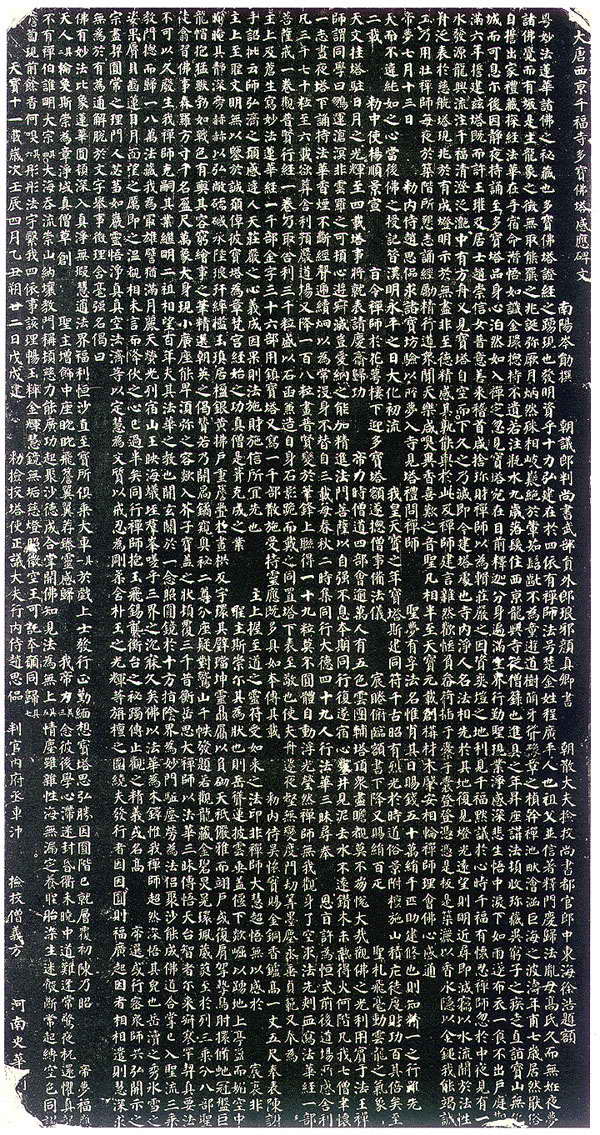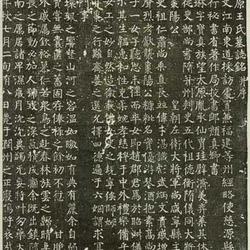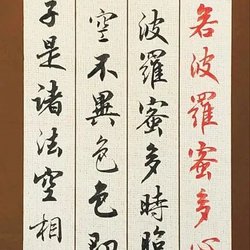"Duobao Pagoda Stele", the full name is "Duobao Pagoda Induction Stele of Qianfu Temple in Xijing, Tang Dynasty", built on April 20, the 11th year of Tianbao (752), written by Cen Xun, with calligraphy by Yan Zhenqing, inscription by Xu Hao, inscription by Shi Hua, thirty-four lines , with sixty-six characters, now in the Forest of Steles in Xi'an. The inscription says that when monk Chu Jin of Longxing Temple in Xijing was reading the Lotus Sutra quietly at night, it seemed as if the Duobao Pagoda appeared in front of him all the time. He was determined to turn the Duobao Pagoda in his imagination into reality. In the first year of Tianbao, Qianfu was selected. Construction of the temple began and it took four years to complete. The Lotus Sutra and the Bodhisattva Sutra are written every year in Qianfu Temple for the emperor and the common people. This has special significance in the history of Buddhism.
This stele is Yan Zhenqing's early famous work. The writing is respectful and sincere, directly related to the writings of the two kings, Ou, Yu, and Chu Yufeng, and it has obvious similarities with the writings of the Tang Dynasty. It shows that Yan Zhenqing was learning from the calligraphers of his predecessors. He pays great attention to absorbing nutrients from the folk art of calligraphy. The whole article has a strict structure, with black silk borders between the lines, and the dots and strokes are round, dignified and beautiful. Every stroke and stroke appears to be moving in silence, and it is ethereal. Although this stele cannot be called the masterpiece of Yan Zhenqing's mature period, and has a very different style from the "Yan Family Temple Stele" and "Magu Xian Tan Ji" he later wrote, it is the first chapter of Yan's book and is Yan Kai's success. As the first step, most people who want to learn facial expressions start from this stele and enter into its secrets.

Rubbings collected by the National Palace Museum in Taipei
Appendix: Notes on Rubbings of "Duobao Pagoda Sensing Stele"
"Duobao Pagoda Stele", the full name of which is "Duobao Pagoda Induction Monument at Qianfu Temple in Xijing, Tang Dynasty", was erected in the 11th year of Tang Tianbao (752). It was originally located at Qianfu Temple in Andingfang, Chang'an in the Tang Dynasty, but was moved to the Forest of Steles in Xi'an during the Song Dynasty (Figure 1). Height 285 cm, width 102 cm, 34 lines of text, 66 characters per line. Cen Xun wrote the article, Yan Zhenqing wrote the book, Xu Hao wrote the title, and Shi Hua published the stone.
The inscription narrates the process of Zen Master Chu Jin, a monk in the Tang Dynasty, who vowed to build the Duobao Pagoda and related Buddhist activities. Emperor Xuanzong of the Tang Dynasty once donated 500,000 pieces of silver and thousands of pieces of silk to erect the pagoda. After the death of Zen Master Chu Jin, Emperor Xuanzong of the Tang Dynasty sent a special envoy to express condolences, supervise the funeral, and personally wrote on the forehead of the pagoda. The important influence of Buddhism in the social life of the Tang Dynasty can be seen here.
Yan Zhenqing (709-785), a native of Jingzhao for ten thousand years, was originally from Langye Linyi and had the courtesy name Qingchen. He inherited his family education from a young age and worked hard to encourage himself. Kaiyuan Jinshi. During the Anshi Rebellion, he served as the prefect of Pingyuan, and successively moved to the position of Minister of the Ministry of Punishment and the Crown Prince. He was upright, upright and courteous. He was not called by his name in the world, but he was the only one named Lu Gong. Later, he was tabooed by the treacherous minister Lu Qi. During Dezong's reign, Li Xilie rebelled. He valued the country and went to the enemy's camp in person, showing his righteousness, but was eventually killed by the enemy.
Yan Zhenqing is one of the most influential calligraphy masters in the history of Chinese calligraphy. Su Shi, the great calligrapher of the Song Dynasty, said: "The poetry reaches Du Zimei, the writing reaches Han Tuizhi, the painting reaches Wu Daozi, and the calligraphy reaches Yan Lugong. The changes in ancient and modern times have been completed by all the people in the world." Yan Zhenqing had many calligraphy monuments in his life, Xi'an The Forest of Steles contains 7 kinds of stele: "Duobao Pagoda Stele", "Zang Huaike Stele", "Guo Family Temple Stele", "Setting Competition Stele", "Yan Qin Li Stele", "Ma Lin's Broken Stele" and "Yan Family Temple Stele". The "Duobao Pagoda Stele" is the oldest among all the stele editions and was created when Yan Zhenqing was 44 years old. Ming Sun's postscript says: "This is Lu Gong's most uniform and stable calligraphy. It is also full of charm and beauty, with a touch of vulgarity. It is the originator of modern historians."
In the Northern Song Dynasty rubbings, the word "Li" in the 31st line "Give me the emperor's power" has not been damaged. The characters on the entire stele are all square, and the connection between the calligraphy and painting is very clear.
In the rubbings of the Southern Song Dynasty, the word "Chise" in the words "Dig a well and see mud" in line 15 is intact, the word "Li" in line 31 "Give it to my emperor's power" (Picture 2), and the word "Tuo" in "Wang Ke Tuo" in line 33 is slightly missing. damage.
On the rubbings of the mid-Ming Dynasty, the word "Tu" in the word "Gua" in the 14th line of "Astronomical Gua" is intact, and the word "Qian" in the 24th line of "Qian Cun Qian Ming" is intact.
Rubbings from the late Ming Dynasty and early Qing Dynasty, the word "gui" in the 31st line of "Give me the emperor's power" is intact, and the upper left half of the word "I" is half le (le, a texture formed by the weathering of stone). The 6 words in the 32nd line "Buddha knows that seeing the Dharma is nothing", the 8 words in the 32nd line "The king of space can be entrusted with the origin and return to the same place", and the last line "The doctor is serving Zhao Si" all have 7 words.
In the Qianjia rubbings, the word "gold" in line 9 of "Yin with a golden hammer" has not been erased. The vertical stroke of the word "Qian" in the "Qiangufa title" on line 33 is intact.
In the early stage of original rubbing, you should pay attention to whether the 31st line of "force" and the 15th line of "chisel" have been inked. It can be seen from Figure 1 that a large piece of the lower middle part of the last 4 lines of the stele was damaged during the Kangxi period of the Qing Dynasty. According to the "Rubbings of the Late Ming and Early Qing Dynasties", all the characters in the 31st to 34th lines were damaged after that. If you see that the above words are not damaged, you should examine them carefully. If they were made from original stones, the rubbings must be no later than the early Qing Dynasty, but most of them are engravings. From the late Qing Dynasty to the Republic of China, there were many stele shops around the Forest of Steles in Xi'an, and many families carved "Duobao Pagoda Sensing Stele" in stone. The mounted copy has been passed down for about a hundred years, and its appearance is quite old. A friend once had two copies in his collection, and he was delighted to tell them that the "strength" of "Give it to my Emperor's Power" and the "chisel" of "Dig a Well to See Mud" were both in good condition and should be inscriptions from the Song Dynasty. They were sent to my office at the Forest of Steles Museum and displayed for reading. One is thinner and the other is slightly fatter. The large shapes are all present, but they cannot be written in detail. For example, in the first line of the fat version (Picture 3), the upper right point of "Sense" in "Duobao Pagoda Sensing Stele" is separated from the horizontal painting (connected to the original carving), and the last two strokes of "See" in the 15th line of "Digming wells to see mud" are inconsistent with the right vertical strokes. Lianlian (the original carvings are connected), etc., the stipples are not in place, so it should be a late Qing and Republic of China edition. The Song rubbings collected in the Palace Museum (Figure 4) are paired with the reprinted edition for comparison. There is no secret to the identification of inscriptions. It is to carefully compare each stroke, each painting, and each stone flower with the original rubbings from different eras. Do not judge it as an original rubbing or even an ancient rubbing from the Song and Ming Dynasties at a glance. Mr. Zhan from Jiangxi, a member of the "Collection" club, submitted the manuscript and said: "The author has spent the past two years reviewing a large amount of information on stele studies and visited many experts on stele studies and famous figures in the calligraphy and collection circles. I think this The rubbings of "Duobao Pagoda Stele" (pictures 5 and 6) are from the Song Dynasty." In fact, Mr. Zhan's collection is also a late Qing and Republic of China reprint. Compared with the original stele made in the Song Dynasty, the original stele is thinner, wither and lifeless, and lacks the rich and powerful charm of the original stele. Like the aforementioned reprinted version (Figure 3), many of the stipples in this version are not in place. For example, the upper right point of the "feeling" in the first line of "Induction Stele". The author carefully examined the original rubbings and original stele from different eras. This point is connected with the horizontal painting. But this version is disjointed (Figure 5). In addition, the "Li" in the Southern Song Dynasty's rubbing of "Give me the power of the emperor" has been damaged (Picture 2). This time the "Li" character (Picture 6) was cut with a knife several times to imitate stone flowers, but it is extremely unnatural and artificial. The chisel marks are very obvious. Famous steles from the Han and Tang Dynasties currently sold to tourists in and around Xi'an Forest of Steles Museum include the "Duobao Pagoda Sensing Stele", etc. Most of them were carved by farmers in Chang'an County, and you can sometimes buy one for 5 yuan or 10 yuan.
The Song Dynasty rubbings photocopied by the Cultural Relics Publishing House, "Tang Yan Zhenqing Shuduo Pagoda Stele", "The Essence of Ancient Epigraphic Rubbings Collection of Peking University Library" contain the complete rubbings from the mid-Ming Dynasty, and "Xi'an Forest of Steles" contains the collection of late Ming and early Qing rubbings, which can be used as school monuments refer to.




















